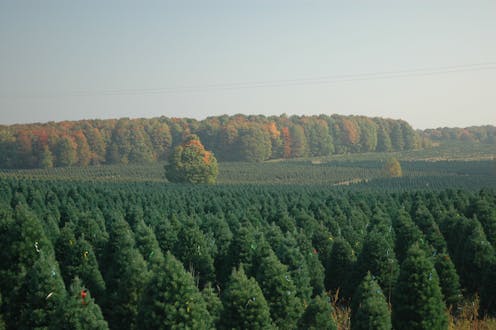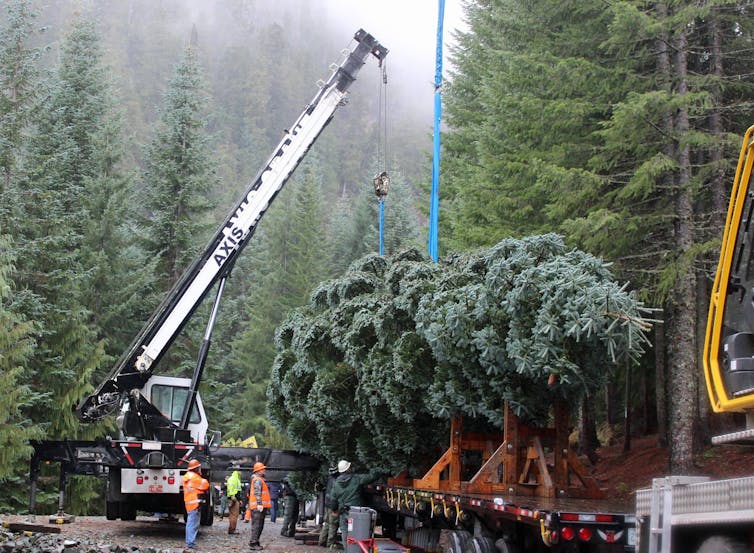Don't stress about what kind of Christmas tree to buy, but reuse artificial trees and compost natura
Both natural and artificial Christmas trees have environmental impacts, but they're not major. What matters most is what happens to the trees after the holidays.

Environmentally conscious consumers often ask me whether a real Christmas tree or an artificial one is the more sustainable choice. As a horticulture and forestry researcher, I know this question is also a concern for the Christmas tree industry, which is wary of losing market share to artificial trees.
And they have good reason: Of the 48.5 million Christmas trees Americans purchased in 2017, 45 percent were artificial, and that share is growing. Many factors can influence this choice, but the bottom line is that both real and artificial Christmas trees have negligible environmental impacts. Which option “wins” in terms of carbon footprint depends entirely on assumptions about how long consumers would keep an artificial tree versus how far they would drive each year to purchase a real tree.

From seedling to wood chipper
Many consumers believe real Christmas trees are harvested from wild forest stands and that this process contributes to deforestation. In fact, the vast majority of Christmas trees are grown on farms for that express purpose.
To estimate the total impact of something like a Christmas tree, researchers use a method called life cycle assessment to develop a “cradle to grave” accounting of inputs and outputs required to produce, use and dispose of it. For natural Christmas trees, this covers everything from planting seedlings to harvesting the trees and disposing of them, including equipment use, fertilizer and pesticide applications, and water consumption for irrigation.
Life cycle assessments often will also estimate a system’s carbon footprint. Fuel use is the biggest source of greenhouse gas emissions in Christmas tree production. Using 1 gallon of gas or diesel to power a tractor or delivery truck releases 20 to 22 pounds (9 to 10 kilograms) of carbon dioxide into the atmosphere.
On the positive side, Christmas trees absorb and store carbon from the atmosphere as they grow, which helps to offset emissions from operations. Carbon represents about 50 percent of the dry weight of the wood in a tree at harvest. According to recent estimates, Christmas tree-sized conifers store roughly 20 pounds of carbon dioxide in their above-ground tissue and likely store similar amounts below ground in their roots.
However, using 1 gallon of gasoline produces about the same amount of carbon dioxide, so if a family drives 10 miles each way to get their real tree, they likely have already offset the carbon sequestered by the tree. Buying a tree closer to home or at a tree lot along your daily commute can reduce or eliminate this impact.
And natural trees have other impacts. In 2009, Scientific American specifically called out the Christmas tree industry for greenwashing, because growers’ press releases touted carbon uptake from Christmas tree plantations while ignoring pesticide use and carbon dioxide emissions from plantation management, harvesting and shipping.
Is synthetic better?
Artificial trees have a different set of impacts. Although many people think shipping trees from factories in China takes a lot of energy, ocean shipping is actually very efficient. The largest energy use in artificial trees is in manufacturing.
Producing the polyvinyl chloride and metals that are used to make artificial trees generates greenhouse gas emissions and other pollutants. China is working to reduce pollution from its chemical industry, but this may drive up the prices of those materials and the goods made from them.
Moreover, to consider sustainability from a broader perspective, production of real Christmas trees supports local communities and economies in the United States, whereas purchasing artificial trees principally supports manufacturers in China.

Going head to head
Recently the American Christmas Tree Association, which represents artificial tree manufacturers, commissioned a life cycle assessment comparing real and artificial Christmas trees. The analysis considered environmental aspects of sustainability, but did not examine social or economic impacts.
The report concluded that the environmental ‘break-even’ point between a real Christmas tree and an artificial tree was 4.7 years. In other words, consumers would need to keep artificial trees for five years to offset the environmental impact of purchasing a real tree each year.
One major shortcoming of this analysis was that it ignored the contribution of tree roots – which farmers typically leave in the ground after harvest – to soil carbon storage. This omission could have a significant impact on the break-even analysis, given that increasing soil organic matter by just one percent can sequester 11,600 pounds of carbon per acre.
Reuse or recycle your tree
Consumers can’t affect how farmers grow their live trees or how manufacturers produce artificial versions, but they can control what happens after Christmas to the trees they purchase. For artificial trees, that means reusing them as many times as possible. For natural trees, it means recycling them.
This is essential to optimize the carbon footprint of a real tree. Grinding used Christmas trees and using them for mulch returns organic matter to the soil, and can contribute to building soil carbon. Many public works departments across the United States routinely collect and chip used Christmas trees after the holidays. If local tree recycling is not available, trees can be chipped and added to compost piles. They also can be placed in backyards or ponds to provide bird or fish habitat.
In contrast, if a used tree is tossed into a bonfire, all of its carbon content is immediately returned to the air as carbon dioxide. This also applies to culled trees on tree farms. And if used trees are placed in landfills, their carbon content will ultimately return to atmosphere as methane because of the way materials buried in landfills break down. Methane is a greenhouse gas 21 times more potent than carbon dioxide over a century, so this is the most environmentally harmful way to dispose of a used tree.
All kinds of factors influence choices about Christmas trees, from fresh trees’ scent to family traditions, travel plans and the desire to support farmers or buy locally. Regardless of your choice, the key to relieving environmental angst is planning to reuse or recycle your tree. Then you can focus on gifts to put under it.
Bert Cregg receives funding from the Michigan Christmas Tree Association and the National Christmas Tree Promotion Board.
Read These Next
Midlife weight gain can start long before menopause – but you can take steps early on to help your b
What you do in the years leading up to menopause can help counter the natural hormonal effects of aging,…
Who thinks Republicans will suffer in the 2026 midterms? Republican members of Congress
The president’s party almost always loses seats in the midterms. More than two dozen Republican House…
Resolve to network at your employer’s next ‘offsite’ – research shows these retreats actually help f
Because they can help you get to know more of your co-workers, offsites may build the kind of trust…






